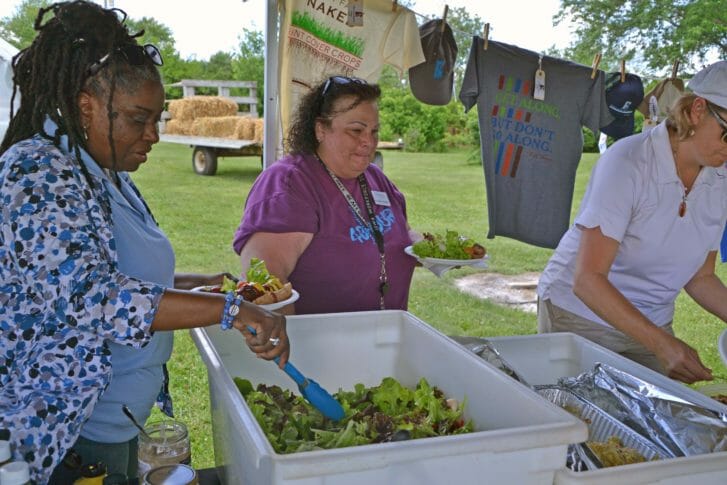Field Day Re-Cap: Grade A Gardens – Garlic, Poultry, and Marketing
The last day of May was hot and sunny for Grade A Garden’s first PFI field day, but a delicious lunch in the shade and the openness of the hosts kept the 50 attendees energized and engaged throughout the day. Jordan Clasen and Whitney Brewer discussed vegetable crop production, use of the layers as fertility in their field rotation, garlic production, and after a break for lunch, showed how they set up their farmers market booth and shared tips on marketing. Photos, quotes, and a summary of the field day are provided, below.
Jordan Clasen began growing garlic in 2010, at the urging of long-time farmers Larry Cleverly and John Whitson. By 2012 he quit his job and planted almost 20,000 garlic plants. In 2013 the farm started a vegetable CSA, added chickens, and increased the garlic field to 25,000 plants. Now with Whitney Brewer on the farm, the pair have 60,000 garlic plants, several acres of diversified produce and 285 laying hens. They maintain a 120-member CSA, and sell at the Des Moines Downtown farmers market and a few restaurants. “We’re at a scale that small enough that we can manage it without going crazy.”
Vegetable Production
Jordan and Whitney installed a high tunnel in December 2017, which they purchased through a kickstarter campaign. They love it, they only thing they would change is to get a bigger one. Jordan got the low tunnels, from Johnny’s, early on in the farm. Right now they are still picking some greens out of them, but next week will rip them out and re-plant. Are the low tunnels worth it? Jordan says, “Heavens, yes. They cost about $1,000 bucks of materials, but they come with the bender and directions from Johnny’s. We plant in there early and harvest a lot of lettuce out of there. Occasionally you fight the wind, which can blow the plastic off, and it’s frustrating but you deal with it.”
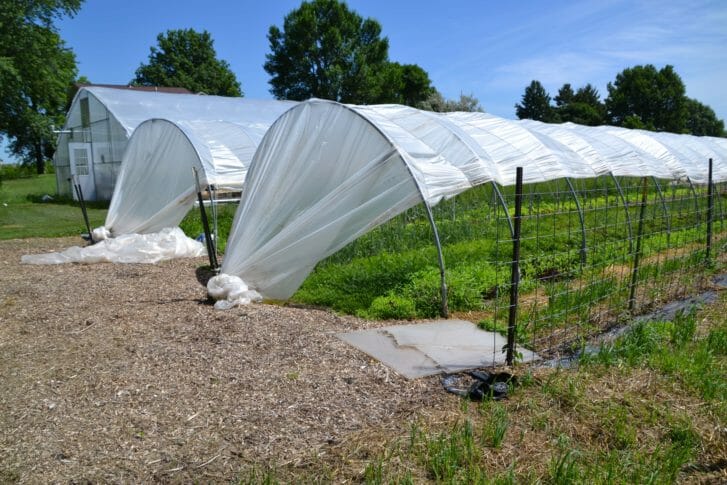
For the tomatoes, Jordan and Whitney use cattle panels with T-posts, over black plastic with straw between the rows. This year Jordan is trying a farmer “no-no”, growing tomatoes in the same place two years in a row. “The panels are a pain to move, and we didn’t have any issues in this spot last year. Greenhouse growers do it, so I thought I’d see how it goes. They’ll definitely move next year.”
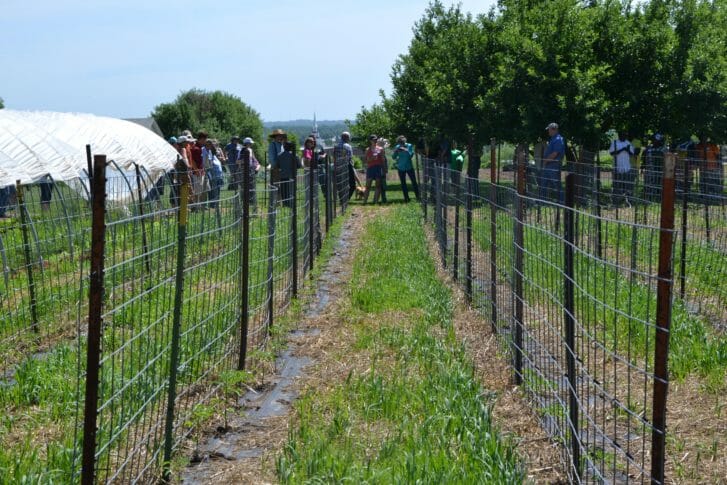
Jordan and Whitney use netting to trellis his peas.
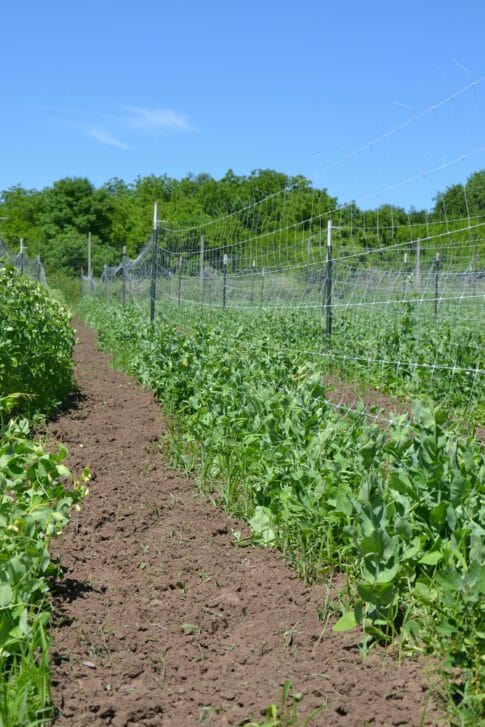
Inside the deer fence, Jordan and Whitney have an extensive crop of potatoes, spanning 10 varieties. Typically they don’t irrigate potatoes, but may run some drip tape if it continues to stay dry. Jordan and Whitney do have Colorado potato beetle. They walk the rows and pick them by hand.

Jordan, somewhat jokingly, considers the deer fence surrounding 4 acres on the property his greatest life achievement.
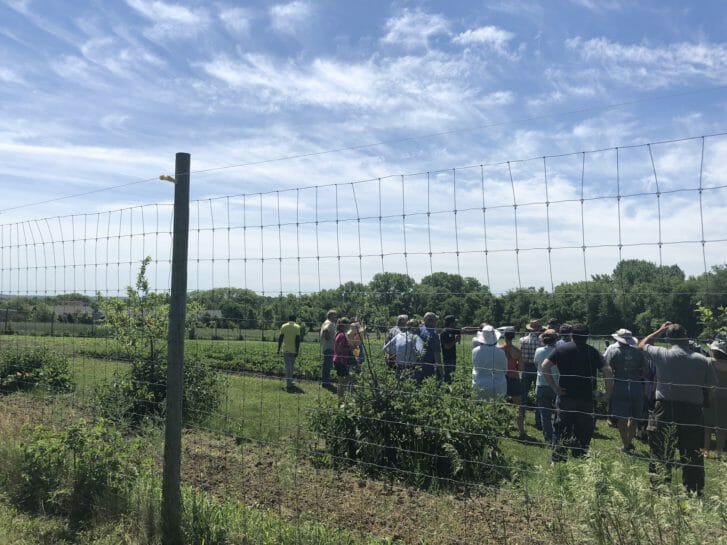
The cover crop mix below, oats, peas and vetch, will be the fall brassicas (they’ll turn it under soon). The chickens were on that plot over a year ago. “I just love following crops after the chickens. This cover crop is looking good – nice dark green color to it. We spread the seed with a Scott’s seed spreader and follow it with a shallow till, and we seem to get good germination.”
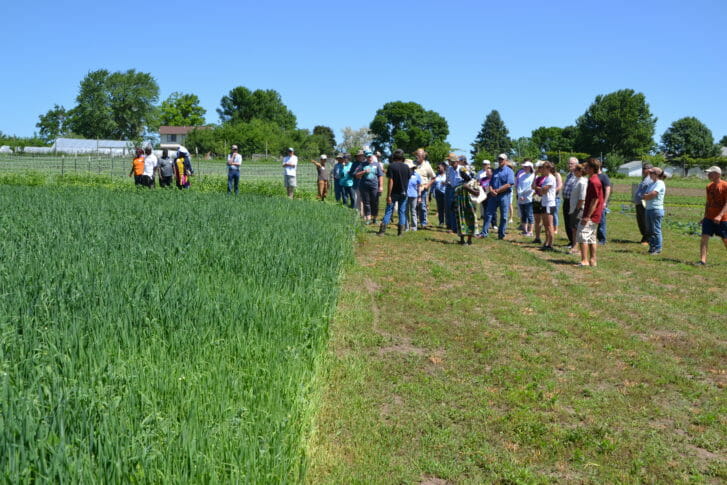
Jordan leads the group past a planting of Salanova. The hot May weather has been tough on lettuce this spring. This crop will get some water soon, but has been on the back-burner while Jordan and Whitney focused on weeding the garlic.
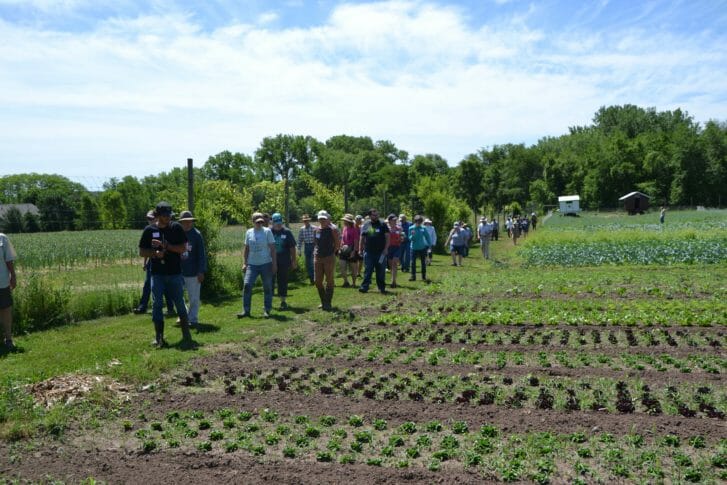
Onions are planted in a field that had garlic in 2017, followed by rye, and then a buckwheat crop. Unfortunately, the buckwheat set some seed. “Sure enough, it popped up like a charm this year.” Jordan says it’s tedious, but not a bad weed to fight. Jordan typically starts his onion from seed, but did purchase some sets from Johnny’s this year because he had poor germination.
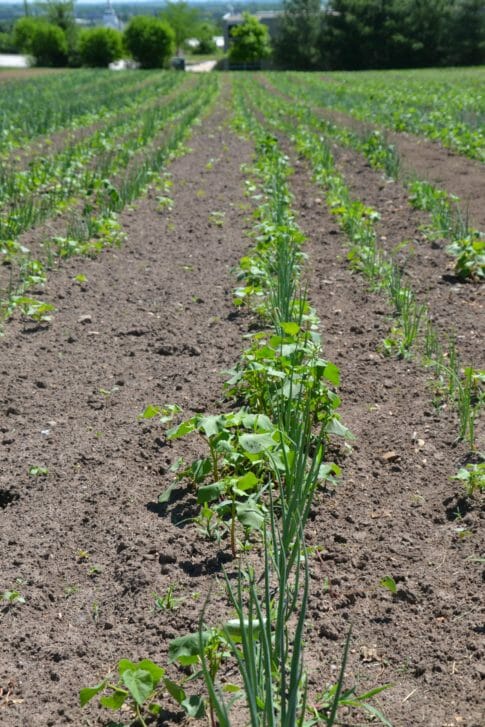
Chickens
“I really didn’t want to be a chicken farmer, and sometimes I still wonder if I want to be a chicken farmer, but they bring a lot of life to the farm, and customers always ask for more eggs. The big fence moves once every 3-4 weeks, the houses move every 7-10 days. The chickens are all I use to fertilize the garlic. The thing I’m trying to figure out is how to better disperse the feeders and the waterers to get more even manure coverage. We get feed from Des Moines Feed; no-soy, non-GMO – I think it’s about the best feed you can get. I’ll mow this down soon – they don’t like the grass over their head.”
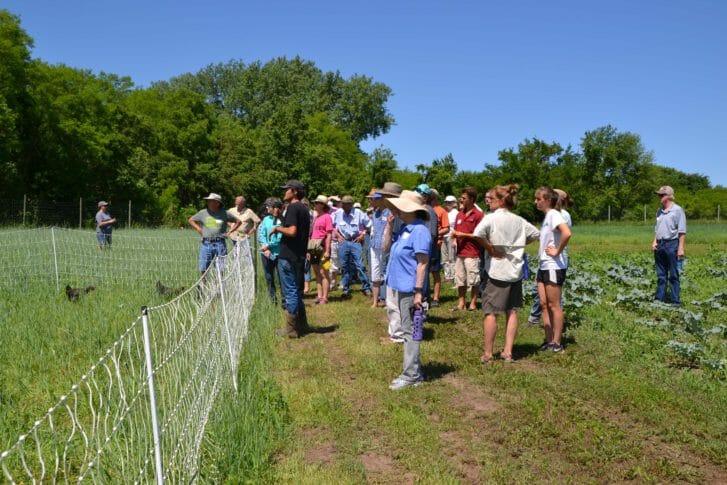
Grade A sells eggs for $5 a dozen at the Des Moines farmers market. Jordan listened to a farmer-to-farmer podcast episode where the farmer said he used the chickens for one year, then followed with two years of vegetables, and that was his secret. “That clicked for me, and I started thinking about how I could work the chickens in more. I was still washing dishes at the time, and was buying a lot of Sustane. Now we rotate with the chickens, and it works great. It takes extra work, but it’s worth it. Plus, I can have the best-looking garlic in the world, but kids visiting the farm always run right to the chickens. Livestock make it feel like a farm.”
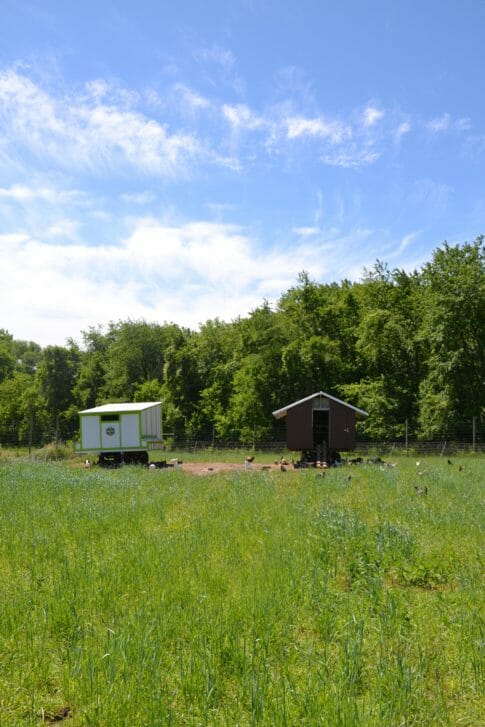
Garlic Production
To prepare garlic beds, Jordan first rips the soil with a Yeoman’s plow, sub-soiling 22 inches deep right where the bed goes. Then he passes with the tiller right over the Yeoman’s plow marks. Last, he just drives the tractor the length of the bed and use the space between the wheel marks for the bed. “I can’t tell you how much time this has saved me. I used to use the BCS walk-behind and would spend hours and hours and days and days making giant raised beds, building the soil and raking them smooth.”
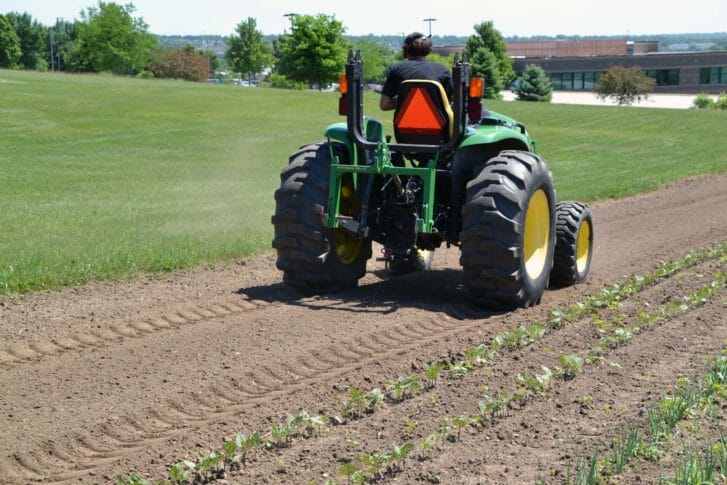
Jordan breaks up the cloves the night before he plants, and separates them out into large cloves and everything else. The large cloves are given priority. After the bed is prepped, he sprinkles them down in 3 lines along the bed. He then adjusts the spacing on his hands and knees, working to keep a consistent grid of about 10 in. x 10 in. (he just eyeballs it). “You see all these people that want fancy dibblers and row markers, but it’s really just a matter of sticking them in – I can keep a pretty consistent grid.” He does, however, plant every clove facing east, pointy-side up, of course. “I like them to wake up with the sun, all the same way.” Jordan plants 3-wide in the bed, but sometimes goes 4-wide. “If I were short on space I would certainly go 4-wide.”
Jordan sorts his bulbs that he saves for seed by size. He has a good market for green garlic, so any “non-primo” cloves get planted very last, packed-in tight, and are harvested for green garlic. “It’s a good way to use up small bulbs, and by saving them until last you know you’ll have plenty of space and nutrients for your big bulbs. I’m trying to save the best, of the best.” Jordan only plants an inch to 1.5 inches deep, which he feels gives him bigger bulbs and certainly makes it easier to harvest.
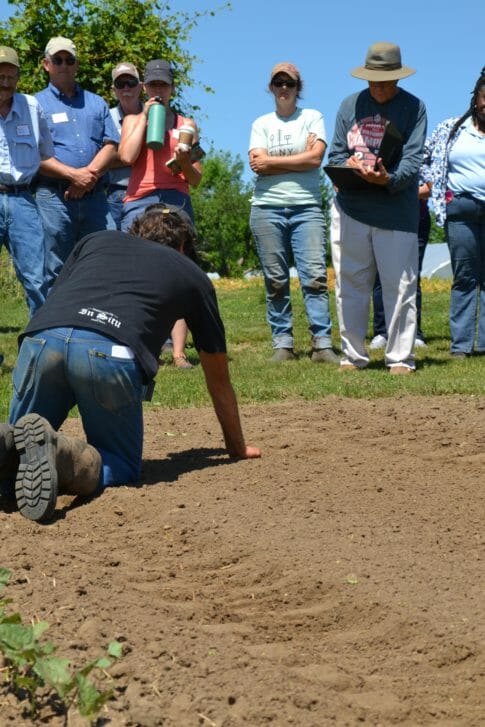
Jordan weeds between the beds with a walk-behind BCS. He puts the BCS in 2nd gear with the tiller raised as high as it will go, and can do the whole garlic field in 90 minutes. “I use an undercutter to harvest, and if I have straw out too far from the plants, the undercutter catches and pulls the straw, and it wants to pull the garlic with it. So I keep the BCS as tight to the plants as I can. With the undercutter, I would say 98% of the garlic gets harvested without any dings.” After the “wave” of garlic comes up, a crew of 3 or 4 picks them up and sorts them in the field into big and small – big on one side of the bed, small on the other. “If you even have to ask, it’s big. We bring them to the end of the field and band them with #64 bands from Office Max, which gives you three wraps around the garlic. Big bulbs we band in 8’s, small bulbs, we put as many as we can in the clump. That way, when we hang it and dry it, we can easily see which are big for seed, and which are small for market.” He dries garlic by hanging the bundles through deer fence hardware mesh, suspended in a barn.

In 2012 Jordan sent a 43-head garlic braid to Filaree Garlic Farm in Washington state as a gift for hosting Jordan during a visit. The garlic variety was special to Jordan – it was seed garlic from Larry Cleverly, that Larry had been saving for 20 years. The following year, most of the growers in Iowa, including Jordan, had asters yellow in their garlic and couldn’t save any for seed. Filaree Farm planted out the braid, and provided Jordan with 20lb of seed garlic the following year, which is now called Iowa German White.
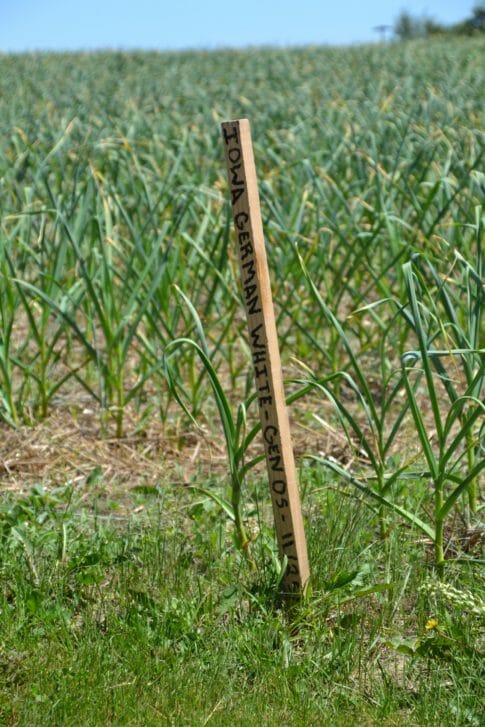
Jordan experimented with a seaweed soak this year, then soaked with an oxidate for 5-7 minutes immediately prior to planting. “I’d say 90% of what I grow are porcelains; they seem to be hardiest for Iowa.” Jordan harvests the scapes, ideally when they’re at full curl. He can sell scapes at the farmers market by the garbage bag-full. “For harvesting the bulbs, the rule of thumb is, when you see only 4 green leaves remaining, it’s time to pull your garlic.”
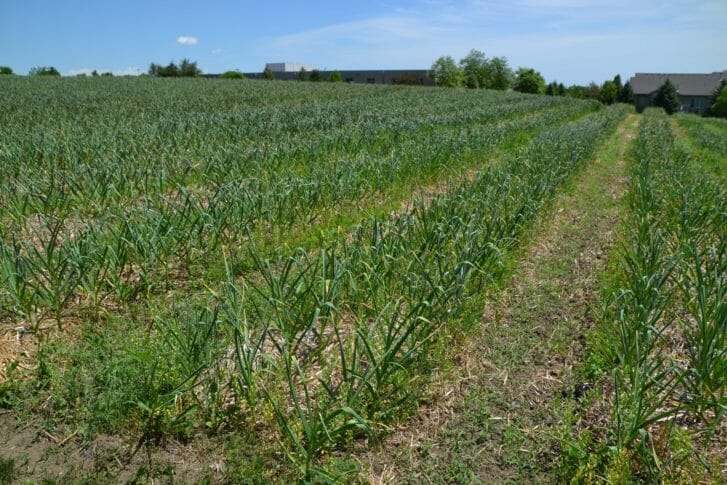
Tips for Marketing
“I worked at Gateway Market for 5 years, so setting up the market stand is enjoyable to me. Nothing we do is too special, we just put good looking produce in wooden boxes, stack ’em high and watch it fly.” Jordan had the shallow boxes made his first year at the farm; they hold 20 pints or 15 quarts about perfectly. The deeper boxes are old apple boxes.
The night before the market, he carefully fills each box, so the “first face” of the booth is done. The backstock is all the cooler. Brewer was skeptical of Jordan’s perfectly composed “first face”, but after a year at the market with him, agreed. She said, “People really do buy with their eyes first. I was used to throwing the display together the day of the market, but it turns out that hour he spends getting things perfect does make a difference. The cascading effect of having multiple layers of produce and straight lines is effective.” Photos of their market booths can be seen on the Grade A Gardens Facebook page.
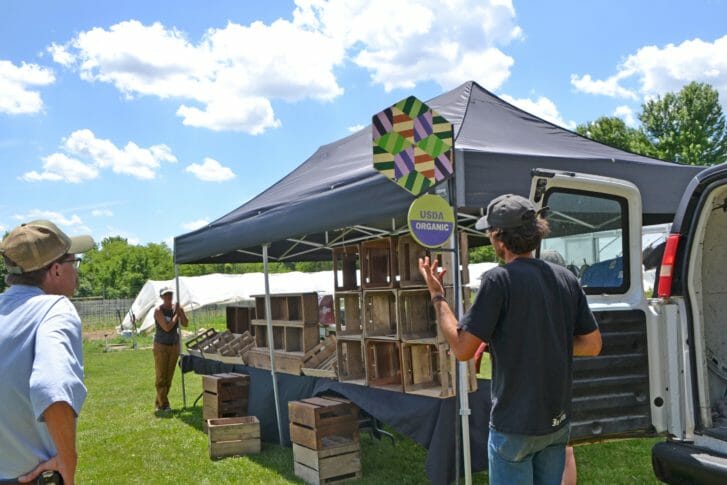
“We never do the same spread twice. I like doing a different booth every week, and we can move the boxes and heights around based on what we’re trying to push.”
A few key points of the farmers market:
1. Have at least two entrances for money (seen on each side of Whitney, below).
2. Keep it fresh: Jordan keeps a bag of ice in the cooler, and puts ice on top of kale and other greens to keep them fresh. They also spritz radishes and other produce with water frequently to keep them looking shiny and attractive. If anything looks wilted, they pull it off and it goes to the chickens.
3. Keep pricing easy. Everything that is bunched, they sell is 1 for $3, 2 for $5; things in bags are a separate price. “85% of the time, people buy at least 2 items with this pricing structure,” says Jordan.
4. Don’t crowd good-looking produce with signage. Having people ask, offers an opportunity to engage, educate, make a sale and get a repeat customer.
5. A crowd attracts a crowd. “We have three people working to keep things moving, and if the produce looks good, it seems to me that people stick around.”
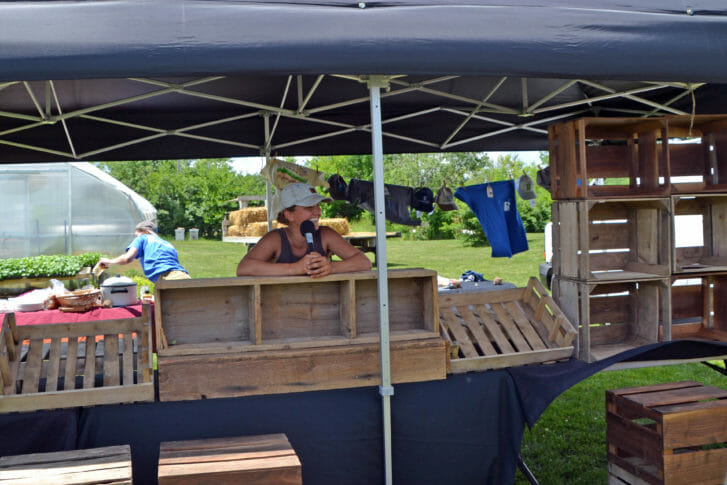
To close the field day, Jordan presented about some of the marketing lessons he’s learned and follows, including:
“90% of my business comes from word of mouth, so keep positive relationships and only sell the best of the best.”
“Do many random acts of kindness. Giving away a bulb of garlic costs me $1 but a might get a loyal customer.”
“Listen to what customers what they want and try to have it first.”
“Keep your product impeccably clean and fresh – always.”
“People buy with their eyes first – display it like you care.”
“Provide excellent customer service – always. A smile goes a log way.”
“Present your product as people are used to seeing it in the store. People want to support local but the product should be familiar.”
“Develop a strategy for social media. I post every CSA Box and every Farmers Market. Show a lot of the good and enough of the ugly from the farm, and have a sense of humor.”
“Build your tribe: Stay close with other farmers. Do your own deliveries. Encourage people to visit the farm. If you mess up an order, make it up to the customer 10 times.”
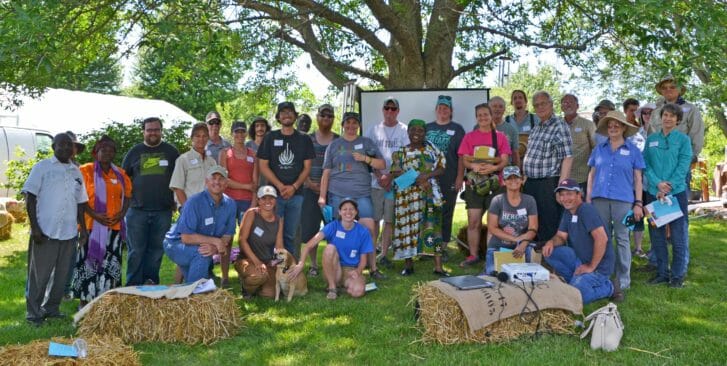
Above: some field day attendees agreed to pose for a group photo – a rare farmer sight!
Below: attendees enjoy brats from Remnant Hills Farm, greens from Grade A Gardens.
